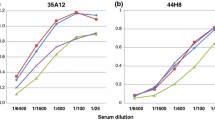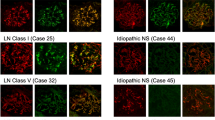Abstract
Renal cell carcinoma (RCC) has been characterized by high expression of three types of disialogangliosides: two based on lacto-series type 1 structure (disialosyl Lc4, GalNAc disialosyl Lc4), the other based on globo-series structure (disialosyl globopentaosylceramide; disialosyl Gb5). The present study established a mAb, 5F3, directed to disialosyl Gb5. 5F3 was established after immunization with RCC cell line ACHN. The major disialoganglioside antigen isolated from ACHN cells, showing specific reactivity with 5F3, was characterized unequivocally as disialosyl Gb5 (V3NeuAcIV6NeuAcGb5) by identification of the core structure as globopentaosylceramide (Gb5) after enzymatic and acid hydrolysis, and by 2-dimensional 1H-NMR spectroscopy. 5F3 does not react with monosialosyl Gb5 (V3NeuAcGb5), Gb5, or any lacto-series structures. 5F3 strongly stained 19 of 41 cases of primary RCC tissue. It reacted with proximal tubules (but not distal tubules) of kidney, microglial cells of cerebrum and cerebellum, goblet cells of stomach and intestine, smooth muscle of various organs. It did not react with parenchymatous cells of various organs, except for kidney epithelia and prostate stroma. Immunostaining of RCC tissue by mAb 5F3, in combination with staining by other antibodies directed to globo-series and lacto-series structures, has prognostic significance in defining metastatic potential of RCC.
Similar content being viewed by others
References
Hakomori S, Tumor malignancy defined by aberrant glycosylation and sphingo(glyco)lipid metabolism, Cancer Res 56, 5309–5318 (1996).
Saito S, Orikasa S, Ohyama C, Satoh M, Fukushi Y, Changes in glycolipids in human renal-cell carcinoma and their clinical significance, Int J Cancer 49, 329–334 (1991).
Saito S, Levery SB, Salyan MEK, Goldberg RI, Hakomori S, Common tetrasaccharide epitope NeuAca2→3Galb1→3 (NeuAca2→6)GalNAc, presented by different carrier glycosylceramides or O-linked peptides, is recognized by different antibodies and ligands having distinct specificities, J Biol Chem 269, 5644–5652 (1994).
Ito A, Levery SB, Saito S, Satoh M, Hakomori S, A novel ganglioside isolated from renal cell carcinoma, J Biol Chem 276, 16695–16703 (2001).
Fukushi Y, Nudelman ED, Levery SB, Higuchi T, Hakomori S, A novel disialoganglioside (IV3NeuAcIII6NeuAcLc4) of human adenocarcinoma and the monoclonal antibody (FH9) defining this disialosyl structure, Biochemistry 25, 2859–2866 (1986).
Folch J, Lees MB, Stanley GHS, A simple method for isolation and purification of total lipid from animal tissues, J Biol Chem 226, 497–509 (1957).
Satoh M, Nejad FM, Nakano O, Ito A, Kawamura S, Ohyama C, Saito S, Orikasa S, Four new human renal cell carcinoma cell lines expressing globo-series gangliosides, Tohoku J Exp Med 189, 95–105 (1999).
Magnani JL, Smith DF, Ginsburg V, Detection of gangliosides that bind cholera toxin: Direct binding of 125I-labeled toxin to thin-layer chromatograms, Anal Biochem 109, 399–402 (1980).
Miyao N, Tsukamoto T, Kumamoto Y, Establishment of three human renal cell carcinoma cell lines (SMKT-R-1, SMKT-R-2 and SMKT-R-3) and their characters, Urol Res 17, 317–324 (1989).
Otani N, Tsukamoto T, Kumamoto Y, Miyao N, Study on in vitro invasive potential of renal cell carcinoma cell lines and effect of growth factors (EGF and TGF-b1) on their invasions, Jpn J Urol 82, 613–619 (1991).
Mizuno Y, Gotoh A, Kamidono S, Kitazawa S, Establishment and characterization of a new human testicular germ cell tumor cell line (Tcam-2), Jpn J Urol 84, 1211–1218 (1993).
Saito S, Orikasa S, Satoh M, Ohyama C, Ito A, Takahashi T, Expression of globo-series gangliosides in human renal cell carcinoma, Jpn J Cancer Res (Gann) 88, 652–659 (1997).
Levery SB, Salyan MEK, Steele SJ, Kannagi R, Dasgupta S, Chien J-L, Hogan EL, van Halbeek H, Hakomori S, A revised structure for the disialosyl globo-series gangliosides of human erythrocytes and chicken skeletal muscle, Arch Biochem Biophys 312, 125–134 (1994).
Miyake M, Ito M, Hitomi S, Ikeda S, Taki T, Kurata M, Hino A, Miyake N, Kannagi R, Generation of two murine monoclonal antibodies that can discriminate N-glycolyl and N-acetyl neuraminic acid residues of GM2 gangliosides, Cancer Res 48, 6154–6160 (1988).
Ito A, Handa K, Withers DA, Satoh M, Hakomori S, Binding specificity of siglec7 to disialogangliosides of renal cell carcinoma: Possible role of disialogangliosides in tumor progression, FEBS Lett 498, 116–120 (2001).
Falco M, Biassoni R, Bottino C, Vitale M, Sivori S, Augugliaro R, Moretta L, Moretta A, Identification and molecular cloning of p75/AIRM1, a novel member of the sialoadhesin family that functions as an inhibitory receptor in human natural killer cells, J Exp Med 190, 793–801 (1999).
Author information
Authors and Affiliations
Rights and permissions
About this article
Cite this article
Ito, A., Saito, S., Masuko, T. et al. Monoclonal antibody (5F3) defining renal cell carcinoma-associated antigen disialosyl globopentaosylceramide (V3NeuAcIV6NeuAcGb5), and distribution pattern of the antigen in tumor and normal tissues. Glycoconj J 18, 475–485 (2001). https://doi.org/10.1023/A:1016281002344
Issue Date:
DOI: https://doi.org/10.1023/A:1016281002344




